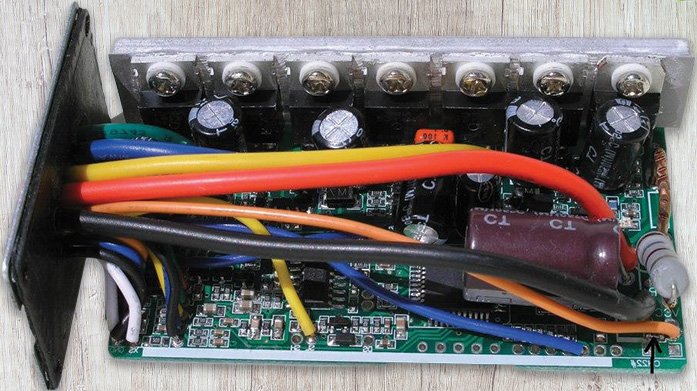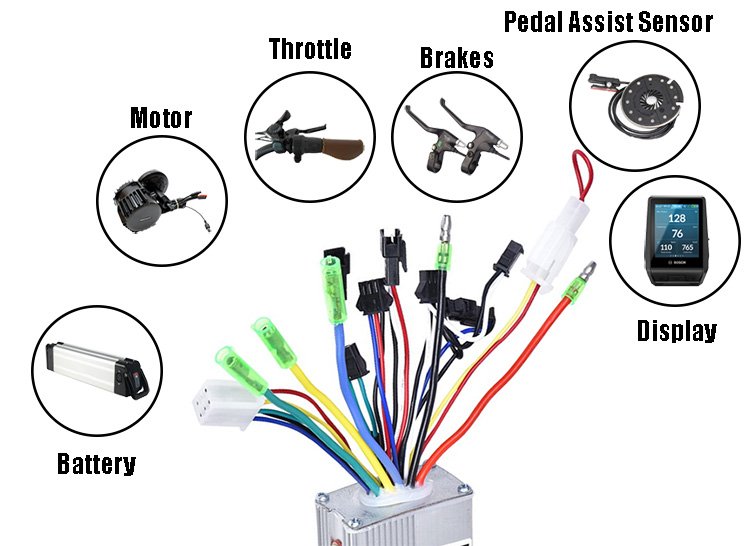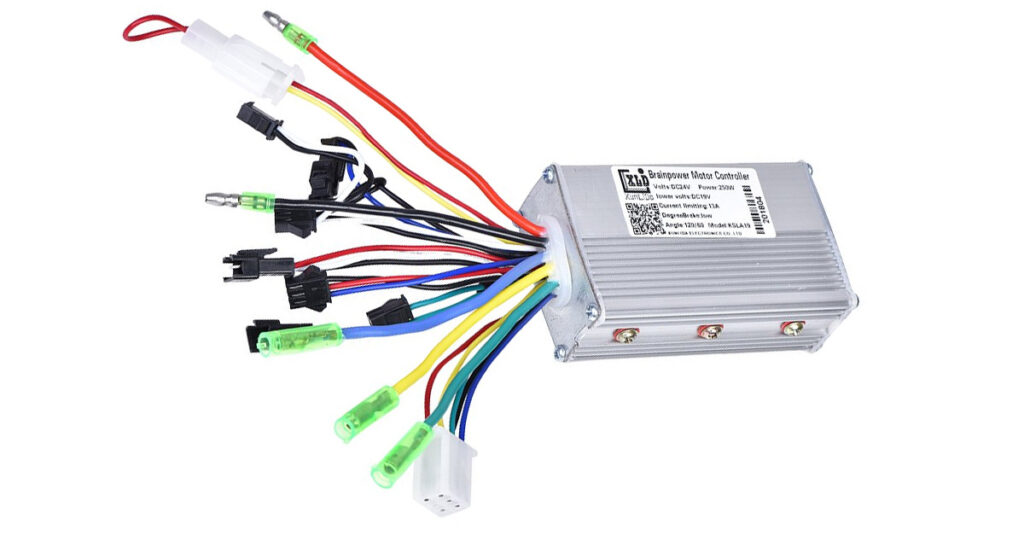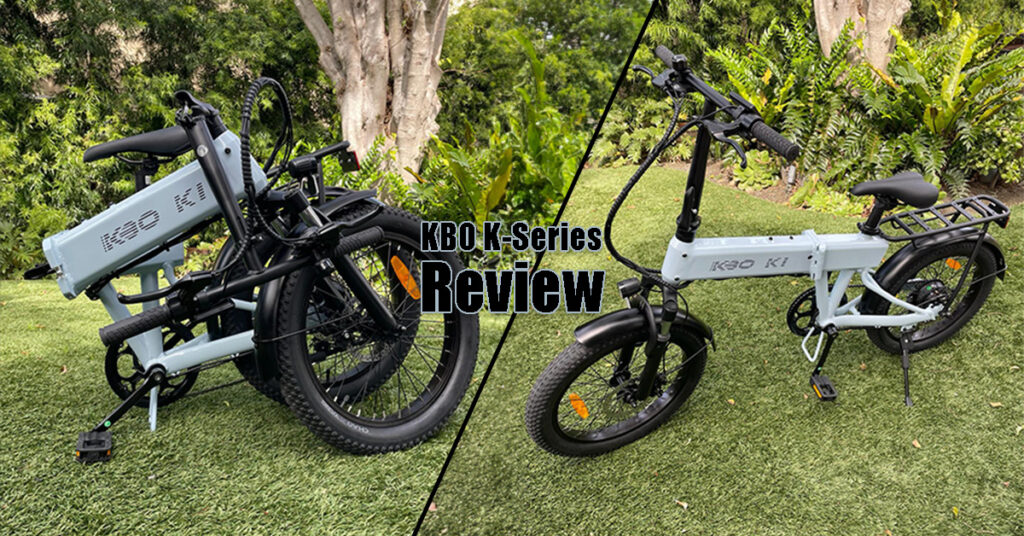Electric bikes have revolutionized the way we commute, exercise, and explore the great outdoors. But have you ever wondered what makes these e-bikes so smart and efficient?
The answer lies in a small yet crucial component: the electric bike controller. Often overlooked, this “brain” of your e-bike plays a pivotal role in how your bike performs, from speed and acceleration to battery management.
In this comprehensive guide, we’ll delve deep into the world of electric bike controllers. We’ll explore what they are, how they work, and why they’re so essential. We’ll also look at different types of controllers, their functionalities, and even guide you on how to choose the right one for your e-bike.
So, buckle up as we take you on a ride through the intricate circuitry that makes your e-bike tick.
- What is an E-Bike Controller?
- What's Inside of an Electric Bike Controller?
- How Does an E-Bike Controller Work?
- What Types of E-Bike Controllers Are Available?
- What Are the Main Functions of an Ebike Controller?
- How to Choose a Right Controller
- Popular Brands and Models of E-bike Controllers
- Practical Tips and Considerations
- Final Thoughts On Electric Bike Controllers
What is an E-Bike Controller?
An e-bike controller is essentially the command center of your electric bike. Think of it as the brain that controls various aspects of your e-bike’s performance.
It interprets signals from the rider’s actions—like pedaling or using the throttle—and translates them into electrical signals that control the motor.
In simpler terms, the controller decides how much power should go to the motor, thereby affecting your speed, acceleration, and overall riding experience.
What’s Inside of an Electric Bike Controller?

Peek inside an electric bike controller, and you’ll find a complex world of circuit boards, sensors, and firmware. These components work in harmony to make your e-bike responsive and efficient.
The circuit board is like the controller’s nervous system, covered in pathways that transmit electrical signals.
Sensors act as the eyes and ears, monitoring variables like speed, pedal torque, and battery level.
The firmware, on the other hand, serves as the controller’s “personality,” containing the software that dictates how the e-bike should respond to various inputs.
How Controller Manages Voltage and Amperage
One of the controller’s key roles is managing the voltage and amperage sent to the motor.
Voltage can be thought of as the “pressure” pushing electricity through the system, while amperage represents the “flow rate” of that electricity.
The controller fine-tunes these parameters in real time. For example, when you’re climbing a steep hill, the controller may increase the amperage to provide more power. Conversely, it might reduce the voltage when you’re cruising downhill, conserving battery life.
In essence, the electric bike controller is a miniaturized powerhouse of technology. It balances numerous factors to give you a smooth, customized ride. It’s not just a box tucked away in your e-bike; it’s the core that makes intelligent biking possible.
How Does an E-Bike Controller Work?
The e-bike controller is a multitasking marvel. It not only controls your speed but also integrates various features to enhance your riding experience. It’s the unseen conductor, making sure every part of your e-bike performs in perfect harmony.

1. The Power Source and Battery Calculations
First and foremost, the e-bike controller draws its power from the bike’s battery. It constantly calculates the battery’s state, ensuring you have enough juice for your journey.
It’s like a vigilant guardian, always aware of how much energy is available and how best to use it.
2. The Motor and Throttle Control
When you twist the throttle or start pedaling, the controller springs into action. It sends the appropriate voltage and current to the motor, dictating how fast or slow you go.
It’s the maestro, orchestrating the motor’s every move to match your riding style and conditions.
3. Beyond Speed: Brakes and Additional Features
But the controller’s job isn’t limited to speed alone. When you hit the brakes, it cuts power to the motor, ensuring a safe and immediate stop.
It also manages other functions like pedal assist, cruise control, and even your e-bike’s lights.
In pedal-assist mode, for instance, the controller uses sensors to gauge how hard you’re pedaling and adjusts the motor assistance accordingly. Want to maintain a constant speed? The cruise control function is also managed by the controller.
What Types of E-Bike Controllers Are Available?
Navigating the world of e-bike controllers can be a bit overwhelming, given the variety of options available. Let’s break down the most common types to help you make an informed decision.
Brushed DC Motor Controllers
These controllers are designed for brushed DC motors, which are simpler and often less expensive than their brushless counterparts.
They control the motor’s speed and direction by altering the polarity of the current flowing through the brushes.
Brushless DC Motor Controllers
As the name suggests, these controllers are for brushless DC motors.
They are more efficient and require less maintenance, but they’re generally pricier. These controllers use complex algorithms to manage motor speed and torque, offering a smoother and more efficient ride.
Controllers with Hall Sensors
Some controllers come equipped with Hall sensors, which provide feedback on the motor’s position. This information allows for more precise control, especially at lower speeds.
If you’re looking for a smoother start and better low-speed performance, this might be the option for you.
Sine Wave vs. Square Wave Controllers
The last category to consider is the type of waveform the controller uses: sine wave or square wave.
Sine wave controllers offer smoother and quieter operation but are usually more expensive. Square wave controllers, on the other hand, are more affordable but can be noisier and less smooth.
By understanding these different types of controllers, you’ll be better equipped to choose the one that best suits your e-bike and riding style.
What Are the Main Functions of an Ebike Controller?
The e-bike controller is more than just the “brain” of your electric bike; it’s the command center that ensures a smooth and safe ride. Let’s delve into its key functions.
Speed and Power Regulation
One of the most important tasks of the controller is managing your e-bike’s speed and power.
By interpreting signals from the throttle and other sensors, it adjusts the voltage and current to the motor. This ensures you get the speed you desire without overloading the system.
Battery Protection
Battery health is crucial for the longevity of your e-bike. The controller plays a vital role in preventing overcharging and excessive discharging of the battery. This not only extends the battery’s lifespan but also safeguards you from potential hazards.
Motor and Transistor Temperature Management
Overheating is a common issue in electric motors and transistors.
The controller monitors their temperatures and adjusts the power output accordingly. This prevents damage and ensures a longer life for these essential components.
Additional Features
Modern e-bike controllers come with a host of additional features. These may include LCD displays that show speed, battery level, and other vital stats.
Some controllers also offer multiple pedal assist levels, allowing you to customize the amount of help you get from the motor. Others may even have cruise control and integrated lights for added convenience and safety.
How to Choose a Right Controller
Selecting the right controller is a pivotal decision that can make or break your e-bike experience. Here’s what you need to consider:
Matching Voltage and Power Rating
Firstly, ensure that the controller’s voltage and power rating match those of your e-bike’s battery and motor. A mismatch can lead to inefficiency, reduced performance, or even damage to your e-bike’s components.
Compatibility with Motor Type
Not all controllers work with every type of motor. Whether you have a brushed or brushless motor, make sure to choose a controller that is compatible. This ensures optimal performance and extends the lifespan of both the motor and the controller.
Importance of Hall Sensors
Hall sensors help in providing smoother and more efficient motor operation. While some controllers can operate without them, having a controller with hall sensor compatibility is generally a good idea for a more refined riding experience.
Programmable vs. Non-Programmable Controllers
Lastly, consider whether you want a programmable controller or a non-programmable one.
Programmable controllers offer more flexibility, allowing you to fine-tune settings like power curves and pedal assist levels. Non-programmable controllers are generally easier to set up but offer less customization.
By paying attention to these factors, you’ll be better equipped to choose a controller that not only meets your needs but also enhances your e-bike’s performance.
Popular Brands and Models of E-bike Controllers
When it comes to e-bike controllers, several brands and models stand out for their quality, reliability, and advanced features. Let’s delve into some of the most popular ones:
- Bafang: Known for its versatility and durability, Bafang controllers are a top pick for both DIY e-bike builders and manufacturers. They offer a range of programmable options and are compatible with a variety of motor types.
- Kelly Controls: Kelly controllers are renowned for their high performance and customizable settings. They are a go-to choice for those looking for advanced features like regenerative braking and precise motor control.
- Grin Technologies: Grin is a brand that focuses on sustainability and efficiency. Their controllers are designed to be energy-efficient while still providing robust performance, making them ideal for long-distance riders. One of their well-known models is Phaserunner.
- Sabvoton: Sabvoton controllers are known for their high power ratings and are often used in high-performance e-bikes. They come with a host of features like multiple pedal assist levels and LCD displays.
- Xbot from Daxiang Technology: Xbot controllers are known for their cutting-edge technology and robust performance. Manufactured by DAXIANG Technology Co., Ltd, these controllers offer a range of programmable features and are often used in high-end e-bikes that require precise control and durability.
- Santroll from Tianjin Santroll Electric Automobile Technology Co: Santroll controllers are another reliable option, especially for those who prioritize energy efficiency. Produced by Tianjin Santroll Electric Automobile Technology Co., Ltd, these controllers come with advanced battery protection features and are highly compatible with various motor types.
Practical Tips and Considerations
When it comes to installing and using an e-bike controller, there are several practical aspects you should consider.
First off, installation can be a bit challenging, especially for beginners. It’s crucial to read the manual carefully and perhaps watch some instructional videos to get it right. If you’re not confident, don’t hesitate to seek professional help.
Matching the controller’s amperage with your motor’s power and your battery’s BMS (Battery Management System) is vital. This ensures optimal performance and prolongs the lifespan of your e-bike components. Incorrect matching can lead to inefficiency and even damage.
Lastly, don’t overlook the extra connections that come with some controllers. These can be used for additional features like lights, cruise control, and more. Utilizing these connections not only enhances your riding experience but also maximizes the functionality of your e-bike.
How Long Does a Good Quality Controller Last?
A top-notch e-bike controller can last anywhere from 3 to 5 years, depending on usage and maintenance.
Just like any other electronic device, its lifespan is influenced by how well you take care of it. Regular check-ups and timely updates can extend its longevity.
Remember, a well-maintained controller not only ensures a smooth ride but also safeguards your e-bike’s overall health. So, invest in quality and make maintenance a habit.
Final Thoughts On Electric Bike Controllers
Choosing the right controller for your e-bike is not just a technical requirement; it’s the linchpin that holds your riding experience together.
From managing speed and power to ensuring battery longevity, the controller acts as the brain behind the operation. It’s the silent orchestrator that makes your rides smooth, efficient, and enjoyable.
Read also: How to Choose an Electric Bike?
Whether you’re a casual rider or a serious e-bike enthusiast, investing time and effort into selecting the perfect controller will pay off in spades. It’s not just about compatibility; it’s about optimizing performance and unlocking the full potential of your e-bike.
So, make an informed choice and ride on!

The founder and the editor-in-chief of the Electric Wheelers blog. With a previous background in IT, sales, and video editing, he has now established himself as a micromobility expert.
He bought his first e-scooter over 5 years ago and since then has owned dozens of e-scooters and e-bikes. His deep understanding of the technical aspects, coupled with a keen eye for market trends, enables him to provide insightful and reliable content.
His commitment to promoting sustainable and efficient urban mobility solutions has made him a respected voice in the community of eco-friendly transportation enthusiasts.




